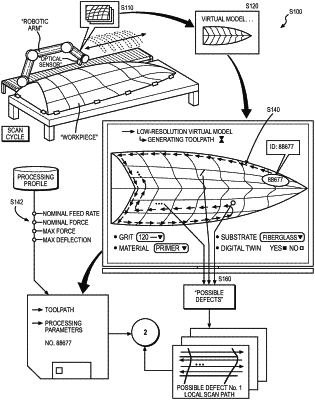| CPC B25J 9/1653 (2013.01) [B24B 51/00 (2013.01); B25J 9/163 (2013.01); B25J 9/1664 (2013.01); B25J 9/1679 (2013.01); B25J 9/1697 (2013.01); B25J 11/0065 (2013.01); B25J 13/085 (2013.01); G06T 1/0014 (2013.01); G06T 7/13 (2017.01); G06T 7/60 (2013.01); G06T 19/00 (2013.01); G06T 2207/10024 (2013.01); G06T 2219/004 (2013.01)] | 20 Claims |

|
1. A method comprising:
accessing a first set of images captured by an end effector while traversing a global scan path over a workpiece during a global scan cycle;
compiling the first set of images into a virtual model of the workpiece;
generating a first toolpath for the workpiece based on a geometry of the workpiece represented in the virtual model;
assigning a first target force to the first toolpath;
based on the first set of images, detecting a first defect indicator in a first workpiece region of the workpiece;
based on the first defect indicator, accessing a second set of images captured by the end effector while traversing a local scan path over the first workpiece region during a local scan cycle;
based on the second set of images, characterizing the first defect indicator as a first defect repairable via material removal from the workpiece;
generating a repair toolpath for the first defect based on a first geometry of the first workpiece region represented in the virtual model;
during a repair cycle, via a set of actuators coupled to the end effector, navigating a sanding head across the first workpiece region according to the repair toolpath, the sanding head coupled to the end effector; and
during a processing cycle:
accessing a first sequence of force values output by a force sensor coupled to the sanding head; and
via the set of actuators:
navigating the sanding head across the workpiece according to the first toolpath; and
based on the first sequence of force values, deviating the sanding head from the first toolpath to maintain forces of the sanding head on the workpiece proximal the first target force.
|